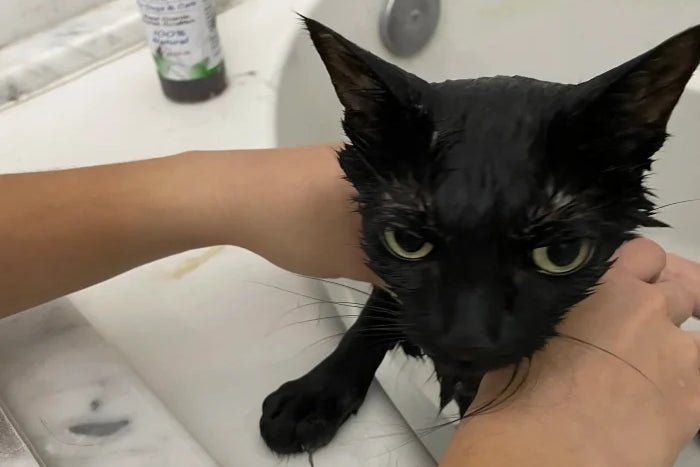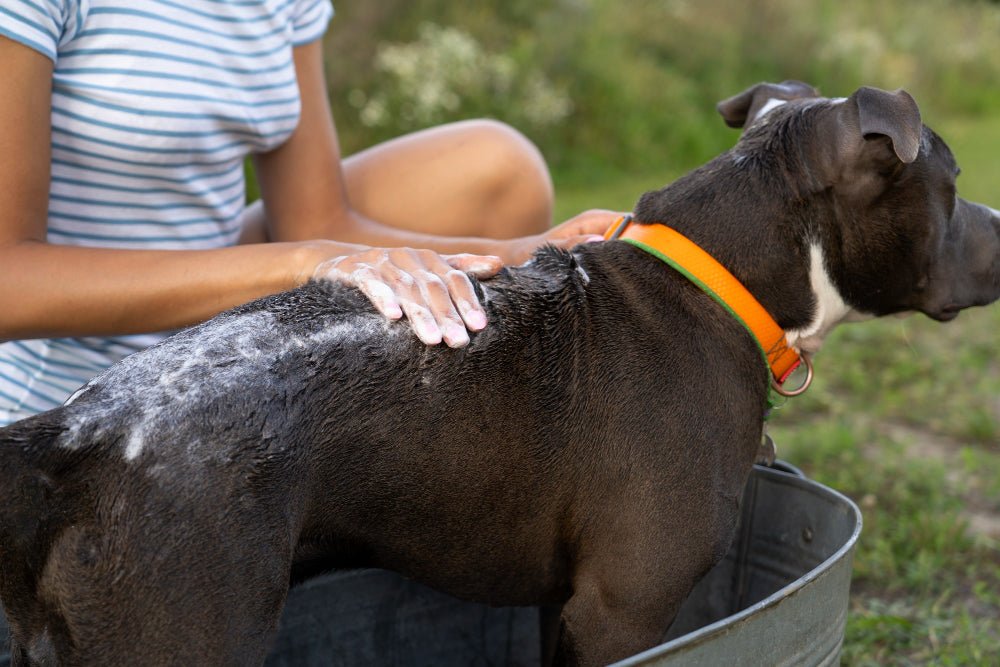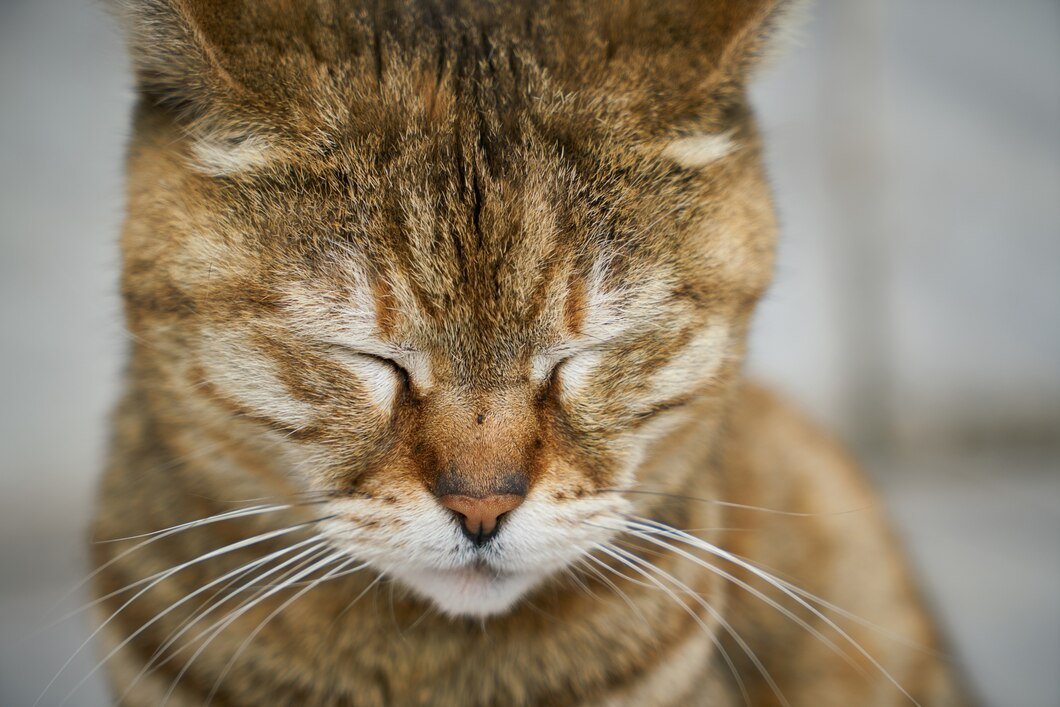PawPurity Blog - Natural Pet Care Tips & Expert Advice
Welcome to the PawPurity Blog! Discover expert pet care advice, natural grooming solutions, and tips for keeping your furry friends healthy and happy. Learn about tear stain removal, organic pet products, proper pet hygiene, and holistic approaches to pet wellness. Our comprehensive guides help you provide the best care for your dogs and cats using safe, natural ingredients.
Cat Dermatitis – Causes & Cures
Are you a cat parent trying to figure out what is causing your sweet little kitty’s skin irritation? If so, you may be dealing with dermatitis – an inflammation caused most often by allergies. Thankfully, this common issue can usually be managed and cured at home with the help of natural and/or medicinal antibiotics and topical creams. In this blog post, we will discuss some common causes of cat dermatitis and various treatments that could provide relief for your feline friend. What is Dermatitis in Cats? According to Canadian Veterinary Journal, cat dermatitis is an allergic reaction in dogs and cats. It is also termed Atopic Dermatitis or, more generally, skin allergies of cats. Cat dermatitis is a condition in which the skin and fur of cats become inflamed, often resulting in redness, itchiness, and scaly bumps or lesions. The condition has several potential causes, including bacterial or fungal infections, allergies to food or environmental hazards, parasites like fleas or mites, or even underlying medical conditions such as diabetes or kidney disease. Diagnosis typically involves a history of the animal’s symptoms and lifestyle and may be supplemented with blood tests and imaging to rule out secondary causes. As far as epidemiology is concerned, cat dermatitis can occur at any age but is more common in younger cats than in older ones. Poor grooming habits can also increase risk as more bacteria accumulate on the skin’s surface. Treatment depends on the exact cause but often includes nourishing shampoos and topical ointments along with changes in diet and increases in hygiene care to help reduce irritation. Types of Dermatitis in Cats Like all other species, cats can be affected by various skin conditions. Dermatitis is one of the more common issues, and there are three distinct forms: allergic dermatitis, parasitic dermatitis, contact dermatitis, and several food allergies. Allergic dermatitis Allergic dermatitis is generally caused by an immune system reaction to allergies; this may manifest as dry or itchy skin and hair loss. Parasitic dermatitis Parasitic dermatitis often thus arises from flea bites or mites; symptoms typically appear on the head, neck, or back and may include reddened skin or scabs. Contact dermatitis Contact dermatitis originates from exposure to irritants such as certain types of shampoos or detergents; here, it is important to identify the trigger so the cat can receive proper medical attention. Food Dermatitis Food dermatitis is a common health problem seen in cats with an allergic reaction to a certain food or ingredient they’ve ingested. It’s important for pet owners to be aware of the signs of this condition so that they can get their furry friend the help they need as soon as possible. Cats may present several different physical symptoms when suffering from food dermatitis, including excessive scratching and itching, redness or swelling on their lips and around their eyes, and inflamed skin lesions or bumps. Solar Dermatitis Solar Dermatitis in cats is an inflammatory skin condition caused by direct sun exposure. It is often seen in lighter-colored cats or cats with thin fur coats due to increased vulnerability to the ultraviolet radiation of the sun. Symptoms can range from sunburn or itching to crusting and hair loss on exposed areas of the body such as the ears, nose, unprotected areas of legs, nipples, and all other parts which are not covered by fur. Miliary dermatitis Miliary dermatitis in cats is a distressing condition that causes extreme itching and coat loss. It has no single cause and is linked to an allergic hypersensitivity reaction of the skin. However, the trigger can vary greatly. To diagnose miliary dermatitis, a veterinary doctor must assess your cat’s symptom presentation. It is imperative that cat owners recognize these types of dermatitis in their cats to promptly address them with prescribed medical treatments. Causes of Cat Dermatitis There are a variety of causes for this condition, the most notable being allergies to environmental substances such as pollen, dust mites, or insect bites. Other causes include bacterial or fungal skin infections, exposure to certain insecticides or cleaning products; nutritional deficiencies; flea infestations; metabolic disease; hormonal imbalances; exposure to toxins; mange mite infection, or chronic stress. It’s important to remember that cats with existing health problems are more prone to developing dermatitis due to weakened immune systems. To identify the underlying cause of your cat’s symptomatic dermatitis, it will be important for veterinarians to consult your pet’s medical history and perform several diagnostic tests, including allergen testing, skin biopsies, or blood tests. Signs of Feline Dermatitis It’s easily recognized by the presence of redness, itching, scabbing, crusty bumps, and hair loss on the cat’s skin. Other signs to look out for include the following; persistent licking scratching at one particular spot darkening or discoloration of the affected area thickening or scaling of the skin bald patches. barbering (hair pulling) noticeable lesions In more severe cases, you may observe pus-filled sores and wounds on the paws or elsewhere on the body. If you suspect your cat has signs of feline dermatitis, it is important to take them to a vet immediately, as treatment options should be determined based on the underlying cause. How is Cat Dermatitis Diagnosed? Cat dermatitis is typically diagnosed by a veterinarian observing your cat’s visible symptoms and taking a full medical history. It can also be helpful for the veterinarian to perform some additional tests, such as; blood tests urine tests skin scrapings patch testing fur plucks skin swabs fecal analysis biopsies The information gathered from these tests can help the vet to make an accurate diagnosis. For severe cases of dermatitis, further tests may be necessary to rule out other underlying causes of skin problems. This helps the veterinarian formulate the best way to treat your fur baby’s cat dermatitis so they can get back to feeling happy and healthy in no time. Treatments for Cat Dermatitis Cat dermatitis is a relatively common condition in cats, typically triggered by flea bites and other allergies. While most cases can be alleviated with simple lifestyle adjustments, more severe conditions may require additional treatments. Diagnose and eliminate the allergens Non-chemical, organic shampoos are crucial to providing cat allergies and dermatitis relief Eliminating allergens has long been a mainstay in treating dermatitis in cats. So often, the causes are the chemicals in cat grooming products. Helping your cat find relief may be as simple as changing shampoos to one that is natural with healing ingredients such as nettle leaf, red clover, aloe vera etc. Also, simple environmental and dietary changes can help reduce the number of irritants that come into contact with your cat’s skin and relieve symptoms of this skin disorder. By cleaning carpets and furniture more often, using hypoallergenic litter boxes and detergents, regularly grooming your pet with aa non-chemical shampoo, switching to grain-free or hydrolyzed food products, and removing any plants within the house, you can lessen the effects of the allergens for cats. Furthermore, if you have determined what specific substances may be triggering your pet’s allergies, avoiding contact with those items is also advised; learning what is causing their reactions helps tremendously in getting their itchiness under control. Dermatitis is an uncomfortable condition for felines, but by managing the allergen levels in their immediate environment, it can be treated successfully. Antihistamines and corticosteroids Additionally, antihistamines and topical corticosteroids are often prescribed to reduce symptoms such as itching. However, these medications must be carefully monitored for potential side effects and used only under veterinary supervision. Antihistamines help to reduce the allergic response, while corticosteroids reduce inflammation and itching. Both have unique benefits, so it’s important to discuss these options with your vet before administering any medications to your cat. It is also important that you carefully follow the instructions given by your veterinarian when administering these medications to ensure a successful outcome. Oral antibiotics Oral antibiotics are a common treatment for feline dermatitis; when administered properly, they can control secondary bacterial infections. However, appropriate antibiotic therapy must be determined according to the suspected or identified causative agents. Though the drugs used to treat cats’ skin infections are similar to those used in humans, the dosage and duration of treatments involve veterinary expertise. For best results, it is important to adhere closely to instructions regarding administration frequency, amount, and length of treatment. Besides being effective against contagious bacterial dermatitis, systemic antibiotics also reduce inflammation, resulting in a quicker resolution of clinical features and minimizing the risk of recurring episodes. Medicated and organic shampoos An oft-overlooked part of this care is choosing the right shampoo. Thankfully, many options are available. Organic shampoos may provide fast-acting relief without introducing chemicals into their cats’ environment. If your cat goes outdoors and is subject to fleas and ticks, there are non-chemical repellent shampoos available at PawPurity. Dietary supplements Dietary supplements are an important part of managing feline dermatitis; they help support skin health and reduce inflammation. A vet-approved multivitamin with fatty acids is one of the best options – fatty acids promote healthy cellular walls while providing your pet with a wide range of vitamins and minerals. Additionally, supplements that contain ingredients such as turmeric, evening primrose oil, and omega-3 fish oil can be beneficial, as they all help to alleviate dermatitis signs such as itching or flaking skin. When choosing a supplement, always look for one produced by a reputable manufacturer that has identified dosages for cats on labeling to ensure you are giving your pet the correct amount. Finally, consult your veterinarian before starting any nutrition regimen – their expertise is essential in helping you provide adequate care for your cat’s skin condition. FAQs Is cat dermatitis contagious? Cat dermatitis, or inflammation of the skin, can cause a variety of discomforts like itching, redness, and scaling. But is it contagious? There is no evidence that suggests it is contagious between cats, although some infections causing cat dermatitis can be spread from cats to humans. This means that if your cat has been diagnosed with an infectious form of cat dermatitis, protecting yourself and other members of your household should be a priority. Is dermatitis in cats painful? Dermatitis, an inflammation of the skin, can be painful and uncomfortable for cats. As with other animals, cats experience various symptoms, including irritation, redness, itching, and skin dryness. In extreme cases, they may suffer from deep sores or ulcers and an intense burning sensation. It is important to recognize the signs early and visit your veterinarian for treatment to avoid unnecessary suffering. The expert advice from a vet, combined with proper care, nutrition, and hygiene, will ensure that cats remain healthy and happy despite dermatitis. How long does cat dermatitis last? The duration of cat dermatitis depends on the underlying cause and how prompt treatment is given. With early diagnosis, effective anti-inflammatory medication, plus environmental modifications if needed, it is possible to reduce the severity of the flare ups and manage any chronic symptoms over time. Also, in some cases where there is an underlying infection or parasitical cause involved, the full recovery from cat dermatitis may extend for weeks or months, depending on the specific condition prescribed treatment plan. Final Words In conclusion, cat dermatitis is a common skin disorder that can be uncomfortable for cats and their owners. Knowing the various types and causes of the condition and how to treat it can help alleviate its symptoms and keep your cat healthy. It is important to note that prevention is always better than cure, so make sure to minimize potential triggers such as fleas or allergens in your home. Furthermore, regularly monitoring your cat’s skin will help you catch any issues before they become serious.
Learn moreCat Dermatitis: Causes, Symptoms & Natural Treatments
As a first step, you may also try Flea & Tick Shampoo. More often than not, this shampoo has helped pet owners with a mild case of skin mites without a trip to the vet. If the issue persists, then of course, a vet is needed, but since this shampoo can help keep them away after they are long gone, it's worth trying.
Learn moreWhat Shampoo is Safe to Use on Cats?
Cats have thinner, more sensitive skin than dogs, making them vulnerable to harsh shampoos with sulfates, artificial fragrances, and toxic preservatives. PawPurity’s Biogreen Enriched Shampoo, balanced at a 6.2 pH and made with 20 organic botanicals, gently cleanses while soothing irritation and restoring a healthy, shiny coat — naturally.
Learn morePersian Cat Tear Stain Remedies
We often get questions about how to remove tear stains on Persian cats. With many years of experience in the pet industry and helping these gorgeous little furry members, we would love to share our information. Let us tell you first that teary eyes in cats and staining can be due to multiple causes from infections to allergies to yeast. So first, you need to identify the root cause of Epiphora (watery eyes) in your Persian cat and then decide on the remedy. Primary Causes of Persian Cat Tear Stains Allergies & environment Allergies are a common cause of watery eyes in cats. Your Persian could be allergic of something as simple as house dust, pollen, molds, fleas or its food. Allergies can cause the tears to become irritated and produce more mucus than usual. If your cat’s tear stains are a result of allergies, you may reduce them by changing their diet or using antihistamines. Your veterinarian can make recommendations. Bacterial & Yeast Infection If your cat’s eyes are red and inflamed, they may have an infection, which typically causes watery eyes. A visit to your veterinarian may be necessary. Infections are often cured with prescribed antibacterial or antifungal medications. Tear duct blockage Nasolacrimal duct obstruction may be due to various reasons, such as allergies or infections. When the tear ducts are blocked, tears cannot drain properly. The tears build up in the eye causing watering. In addition, bacteria and yeast may build up around the eyes in the moist areas and cause redness, which can be painful for your fragile little Persian’s eyes. Use Gentle Persian Cat Stain Remover Products Cleaning around a Persian’s eyes require a non-irritating cleanser. If you don’t have any, use a damp cloth to wipe away the debris. While there are many products on the market. PawPurity Tear Stain Remover Kit for Cats is a great option for getting rid of tear stains on your Persian cat permanently. It’s a 100% natural treatment that attacks the heart of the problem; not just a cover up. The kit includes a cleaning solution, lint-free non-irritating application pads and a powerful powder. The solution and powder have powerful plant- and mineral-based natural antibiotics and antifungals. Once the powder is applied, its natural microbe and yeast fighters continue to work while repelling new tears. Start with cleaning the eye area with the Face Stain Remover Shampoo. It’s an extremely gentle foaming cleanser that can be used daily to get rid of debris and eye boogers. Then apply the stain remover solution with the help of an application pad. Now, apply the tear stain remover powder onto the affected area with a gentle toothbrush or fingertip. After 7-10 days of following these steps, your baby Persian’s eyes will be back to their normal beauty. You may have to continue this process once a week as a maintenance program, but it works.
Learn moreHow to Get Rid of Tear Stains on Maltese Dogs
Learn how to eliminate tear stains on Maltese dogs in 7-10 days with our proven 3-step system. Discover what causes tear stains in Maltese, the best natural treatments, and daily prevention tips to keep your light-colored dog looking pristine.
Learn moreHow to Get Rid of Tear Stains on Persian Cats
If you’re the owner of a Persian cat, you’re probably well aware of the struggle to keep their fur clean and free of tear stains. While those big, beautiful eyes make Persian cats so special, they can also be a source of frustration when it comes to keeping them looking their best. But why do Persian cats have such bad tear stains in the first place? Well, there are a few reasons. For one, they have shorter noses than other cats, which causes their tears to constantly run down their face instead of evaporating as they do in other cats. Secondly, they tend to have narrower tear ducts, which also doesn’t help the situation. If you are searching for some good advice on getting rid of tear stains on Persian cats. No worries! I have got you covered. Let’s get started! Why Do Persian Cats Get Tear Stains? Tear stains, also medically termed “Epiphora,” is a condition that affects mostly Persian and Himalayan cats, causing them to have watery eyes. This can be caused by several things, including allergies, infection, and blockages. Treatment will vary depending on the underlying cause but may include medications, surgery, or other therapies. Another notable reason Persian cats get more tear stains than other cats is that they have more fur around their eyes, absorbing tears and becoming stains. So it is definitely their fur as well that contributes to their tear stains. How to Choose the Best Products for Tear Stains? To choose the best product to get rid of tear stains, you first need to identify the root cause of this Epiphora (tear staining) condition. Once you have identified the main reason, you can take suitable actions to avoid them. One of the most prominent causes of tear stains is any sort of fungal or bacterial infection. These microorganisms cause irritation and inflammation, leading to excessive tearing and staining. Therefore, you need to choose specifically those products with antimicrobial properties that work precisely on the microbes and kill them to prevent tear stains. PawPurity Tear Stain Remover Kits are formulated with 100% natural ingredients to fight eye infections caused by dampness and microbial-caused inflammations. The range includes various products like wipes, stain remover powder, and shampoos for cats and dogs to help with the problem of epiphora. Of course, you must follow the product instructions and use this treatment solution for 7-10 days to notice results. The plus point of these products is that they are organic and do not irritate your little furry friend’s eyes. Takeaway Always check out ingredients and formulations when choosing any product for your pets, especially for their eyes, as they are very sensitive and delicate. Keep caring, Keep loving. Thanks for reading!
Learn moreCelebrating the Extraordinary Love of Pet Dads this Father’s Day
Father’s Day is a time when we honor and express our gratitude to the amazing dads in our lives. We celebrate their love, guidance, and unwavering support that has shaped us into who we are today. But let’s not forget that fatherhood extends beyond human children. This Father’s Day, let’s take a moment to recognize and celebrate the incredible bond between pet dads and their furry companions. When we think of dads, images of roughhousing, heartfelt talks, and tireless dedication come to mind. Pet dads embody all these qualities and more, with an extra dose of warmth, love, and laughter. They fill our homes with wagging tails, cheerful meows, and the unconditional affection that only a pet can offer. So, as we celebrate Father’s Day, it’s time to honor the incredible pet dads who provide endless joy and companionship to their furry family members. Recognizing the Love and Dedication of Pet Dads The Unbreakable Bond The connection between pet dads and their four-legged friends is truly something extraordinary. From the first wag of a tail to the gentle purring on a sleepy afternoon, pet dads understand their pets in a way that words cannot express. Their love is a language of its own, spoken through belly rubs, playful games, and comforting cuddles. Tales of Devotion Heartwarming stories abound of pet dads going above and beyond to ensure the happiness and well-being of their furry companions. Whether it’s rescuing abandoned animals, nursing sick pets back to health, or simply being a constant source of comfort, pet dads demonstrate unwavering dedication that knows no bounds. Their selflessness is a testament to the depth of their love. Navigating the Challenges Being a pet dad comes with its own set of responsibilities and challenges. From daily walks and feeding routines to veterinary visits and training sessions, pet dads juggle numerous tasks to ensure their pets lead healthy and fulfilling lives. They face the ups and downs with grace, patience, and a deep sense of commitment, making sacrifices to prioritize the needs of their beloved companions. Honoring the Supportive Nature of Pet Dads Companionship Beyond Measure Pets are more than just furry friends; they provide unwavering emotional support to their dads. Pet dads often find solace in their pet’s unwavering presence, providing a listening ear during challenging times and a source of comfort during moments of solitude. The bond between a pet dad and their furry friend offers a special kind of companionship that words cannot describe. Fostering Active Lifestyles Pet dads know that a healthy pet is a happy pet. They eagerly participate in energetic play sessions, embark on adventurous walks, and encourage their pets to explore the world around them. Through these shared activities, pet dads not only strengthen the bond with their pets but also promote physical well-being and a vibrant lifestyle for their furry companions. A Boost of Happiness The mere presence of a pet dad can light up a room and bring joy to their furry friend’s life. From playful antics that make us laugh to heartwarming moments that melt our hearts, pet dads have a way of spreading happiness wherever they go. Their unwavering love and cheerful demeanor create an atmosphere of warmth and positivity that enriches the lives of both pet and pet dads. Celebrating the Special Moments and Memories Creating Lifelong Memories Pet dads are masters at making memories that last a lifetime. Whether it’s capturing hilarious snapshots during playtime, embarking on memorable adventures together, or celebrating milestones like birthdays or adoption anniversaries, these moments become cherished memories that weave the tapestry of their bond. Laughter and Joy There’s no shortage of laughter and lightheartedness when pet dads are around. They embrace the silliness and mischief that pets bring into their lives, turning even the simplest of moments into a reason to smile. Pet dads know how to find joy in the every day, reminding us to do the same. Treasure the Time Time spent with a pet dad is a treasure to be cherished. From lazy Sunday mornings filled with snuggles to spontaneous adventures that leave pawprints on our hearts, these moments create a tapestry of memories that become the foundation of a beautiful relationship. Pet dads understand the value of time and make every moment count. Expressing Gratitude and Appreciation Thoughtful Gestures and Gifts Father’s Day is the perfect occasion to show appreciation for the pet dads in our lives. Thoughtful gestures like preparing their favorite meal, organizing a pet-friendly outing, or surprising them with a personalized gift can go a long way in expressing gratitude and acknowledging their love and care. Heartfelt Messages of Thanks Words have the power to touch the soul. Taking a moment to pen down a heartfelt message or sharing a simple “thank you” can mean the world to a pet dad. Let them know how their presence has brightened the lives of their pets and how their love and dedication inspire others. Celebrating Together As we celebrate pet dads, let’s also acknowledge their invaluable role within our communities. Encourage fellow pet owners to join in the celebration, sharing stories and photos that showcase the love between pet dads and their furry companions. Together, we can create a ripple of appreciation and gratitude that honors all pet dads. Including All Pet Dads in the Celebration Expanding the Definition Pet dads come in all forms – fathers, grandfathers, uncles, and even close friends. This Father’s Day, let’s embrace the inclusive nature of pet parenthood and celebrate the love and dedication of all those who play a significant role in the lives of our furry friends. A Community of Pet Dads Beyond individual relationships, pet dads form a vibrant community of support and understanding. Encourage readers to connect with other pet dads, sharing experiences, advice, and stories. By fostering a sense of camaraderie among pet dads, we can strengthen the bonds that connect us all. Gratitude and Inclusivity Regardless of their title or role, every pet dad deserves recognition and appreciation on Father’s Day. Let’s extend our gratitude to the pet dads who have touched our lives, acknowledging the unique love and care they provide to their furry family members. Happy Father’s Day! As we honor the incredible pet dads in our lives this Father’s Day, let’s remember that their love knows no bounds. Their devotion, care, and unwavering support make the world a better place for their furry companions. Let us express our gratitude, share their stories, and celebrate the unique bond between pet dads and their four-legged friends, not just on Father’s Day but every day. A Toast to Pet Dads Everywhere! Here’s to the pet dads who have embraced the joys and responsibilities of parenthood, guiding their pets with love and kindness. May their hearts be filled with warmth, their homes with laughter, and their lives with the immeasurable love that only a pet can bring. Happy Father’s Day to all the incredible pet dads out there!
Learn moreHow to Keep Your Dog Clean in Winter
Winter weather can wreak havoc on your dog's coat and skin. Discover essential grooming tips and protective practices to keep your furry friend clean, comfortable, and healthy
Learn moreIs Tea Tree Oil Toxic to Dogs?
This is a question that many pet owners have asked, and the answer is more complex than it may seem. Tea tree oil, derived from the Australian plant Melaleuca alternifolia, has many benefits for humans. However, the same cannot be said for animals, especially cats and dogs, as there are reports that suggest that tea tree oil can be toxic to our furry friends Introducing Tea Tree Oil to Your Dog Tea tree oil has long been used in traditional medicine and home remedies due to its antiseptic, antifungal, antibacterial, and anti-inflammatory properties. In recent years, it has become increasingly popular for use on pets. But is tea tree oil toxic to your furbabies? Yes. Tea tree oil can be toxic especially around cats, meaning extra caution must be taken if you have both cats and dogs. PawPurity does not recommend using tea tree oil on any pets. And, it should NEVER be ingested by any pet. It is essential to understand the potential harm that could be caused by using tea tree oil on your pet before introducing it into their routine. Is Tea Tree Safe for Dogs? Tea tree oil can benefit your dog’s health when used in the right amounts and applied properly. It can help to reduce skin irritations and heal wounds. However, if used in the wrong amounts, it can be just as toxic to dogs as it is cats. Tea tree oil affects cats differently than dogs. While it may have some benefits for skin issues, there are too many risks associated with using tea tree oil on cats. PawPurity recommends keeping tea tree oil away from felines entirely. It is important to note that dogs react differently to tea tree oil than cats. Some may not react, while others may experience an allergic reaction or worse. Potential Tea Tree Toxicity – Symptoms and Risk Tea tree oil should NEVER be ingested. However, when it is used for a skin condition, it can be helpful at times as long as it is only a small portion of the formulation and isn’t applied in a place where your pet is able to lick it. It should never be applied directly to the skin. When tea tree oil is ingested or applied directly to the skin, your pet may experience; Nausea Vomiting Diarrhea Difficulty breathing Irritation Seizures Tremors loss of coordination Organ failure; In severe cases, tea tree oil can cause liver damage. If you suspect that your pet has come into contact with tea tree oil and is having a reaction, take it to the vet immediately for treatment. Additionally, make sure to store tea tree oil out of reach of pets as even small amounts can be toxic if ingested. How to Administer Safely? 1. Consult your veterinarian: The first step when introducing tea tree oil to your pet is to always consult with a veterinarian before using it, as it can be toxic if not used correctly. 2. Apply only topically in the diluted form: Once the vet has cleared the use of tea tree oil, it is important to remember that it is not meant to be ingested. It should only be used topically and diluted with a carrier oil such as coconut or almond oil. This will reduce the concentration and make it safer for the animal. If you don’t know what the safe percentage of tea tree oil is in relation to the other ingredients, then err on the side of caution and don’t use it. It’s not worth risking your pet’s well-being when there are other plant-based formulations that are safe and equally effective for skin conditions. Check out PawPurity’s Intensive Nourishing Shampoo. It is a clean, safe way to address skin problems in dogs and cats. 3. Always do a patch test: Before introducing any product to your animal, it is a good idea to do a patch test on an area of the skin to make sure the pet does not have an allergic reaction. If you decide tea tree oil is the only way to go, monitor your pet closely for any changes in their behavior or appetite after using tea tree oil. 4. Monitor dosage: The amount of tea tree oil applied should also be calculated carefully, as too much can be toxic and lead to adverse effects. Only use a few drops mixed with 1-2 teaspoons of carrier oil on small animals, whereas, for larger animals such as dogs, up to 30 drops of tea tree oil mixed with 4-5 tablespoons of carrier oil may be used. The Final verdict In conclusion, tea tree oil can be beneficial when used correctly and cautiously with the approval of your vet so if you are still wondering if is it bad for dogs, the answer depends on how you use it, where it’s applied, the formulation percentages, and most importantly, do you have your vet’s approval? And is tea tree oil toxic to cats? The answer is yes. PawPurity does not recommend using tea tree oil on any animals, but if you do, please follow the above guidelines. Err on the side of caution. Their health is in our hands. #TeaTreeforDogs #TeaTreeDogs #EssentialOilsForDogs #EssentialOils
Learn moreNatural Tick Spray for Dogs: Safe Plant-Based Protection That Works
Discover why natural tick spray for dogs is the safest way to protect your pet from dangerous parasites. Learn about toxic ingredients in chemical sprays and find the plant-based solution that works.
Learn moreTCVP in Pet Products: UC Study Finds Deadly Chemical in Flea & Tick Treatments
A University of California study found TCVP in pet products - a deadly pesticide present in 34 popular flea and tick treatments. Learn how to identify products containing TCVP, recognize symptoms of exposure, and discover safe, natural alternatives to protect your pets from this dangerous chemical.
Learn moreAre Ticks in Winter Still a Threat to Your Pets?
Wondering if ticks in winter are still a threat to your pets? Discover how these parasites survive cold temperatures, the diseases they carry, and 5 proven ways to protect your furry friends year-round with natural, chemical-free prevention methods.
Learn moreDog Dermatitis Relief: 7 Natural Remedies That Stop the Itch Fast
Atopic dermatitis is one of the most common skin conditions in dogs, often triggered by allergens like pollen, dust, fleas or grooming products. Learn the signs, causes, and natural ways to manage this itchy, frustrating condition and help your dog find lasting relief.
Learn moreWinter Cat Skin Care: Essential Tips for Cold Weather
Protect your cat's skin this winter with expert grooming tips and natural care strategies to prevent dryness and irritation.
Learn moreHow to Keep Your Pets Safe on Halloween
It’s that time of the year again when we all will come together to celebrate Halloween! For pet owners, this can be a fun but also tricky time. Pets can get easily spooked by the noise and costumes, so it’s essential to take some precautions to keep them safe. Halloween can be fun and festive for humans, but it can be a scary and dangerous time for pets. With all the commotion of trick-or-treaters and candy, it’s easy for pets to get lost or injured. Here are a few tips on how to keep your pets safe on Halloween. Let’s get started! 1. Keep your pets indoors Halloween is a spooky time of year, and here are a few reasons why it is essential to keep your pets indoors on Halloween: There are more strangers out and about. Dogs and cats can be skittish around strangers at the best of times, so Halloween, with all its ghouls and goblins, can be particularly daunting for them. There is more noise. Fireworks are common on Halloween night, and the loud bangs can scare even the bravest of pets. There are more risks. With all the extra people and activity on the streets, there is an increased risk of pets getting lost or injured. 2. Keep candy out of reach Candy can be dangerous for pets because it often contains chocolate; poisonous to dogs and cats. Even small amounts of chocolate can make your pet sick. So before you indulge in your Halloween candy, ensure your furry friends can’t get their paws on any. According to American Veterinary Medical Association (AVMA), another reason to keep candy away from pets is that many types of candy are high in sugar and fat, which can be unhealthy for them. So even if your pet doesn’t eat chocolate, it’s best to keep them away from all kinds of candy this Halloween. 3. Be careful with your Halloween decorations As Halloween approaches, many people begin decorating their homes with all sorts of spooky and fun decorations. But if you have pets, it’s essential to be careful with your Halloween decorations and ensure they are pet-safe. Avoid using candles or anything that emits an open flame. Pets can knock over candles and cause a fire. Consider battery-operated candles instead. Be careful with fake cobwebs. Many fake spider webs are made with nylon thread. 4. Protect pets from noise and spooky costumes As Halloween approaches, many people begin to think about how to protect their pets from the noise and commotion of the holiday. But unfortunately, the sound of strangers knocking on the door or the sight of unusual costumes can be downright scary for some animals. First, keep your pet away from the door on Halloween night. If possible, confine them to a quiet room where they can’t see or hear the doorbell ringing or people walking outside. This will help reduce their stress levels. Second, don’t take your dog trick-or-treating with you. The noise and commotion may be too much for them to handle. If you must take them out, ensure they wear a comfortable costume that doesn’t restrict their movement or vision. 5. Put your pet’s Identification tags on them When it comes to Halloween, the last thing you want is for your pet to get lost. So make sure their identification tags are securely fastened to their collar in case they escape out the door while you’re handing out candy to trick-or-treaters. If your pet doesn’t have identification tags, now is the time to get them. You can find tags at your local pet store or online. Include your pet’s name and contact information on the tag. 6. Don’t leave your pets unattended Each year on Halloween, animal shelters see an influx of pets that have been either lost or abandoned. While the holiday can be fun for humans, it can be stressful and dangerous for pets. Dogs and cats may become frightened by the sound of fireworks or the sight of strangers in costumes, which can lead to them running away from home. For this reason, it’s essential to keep a close eye on your pets during Halloween and ensure they are not left unattended, especially if they are left to run loose around the house. With so much commotion, it’s hard to keep track of their whereabouts. Happy Halloween! As you celebrate Halloween with your friends and family, keep your furry friends safe by following these tips. By keeping them inside and away from potential hazards, you can also ensure they have a happy and safe holiday.
Learn moreWhat to Do for an Injured Dog Paw Pad: First-Aid & Care
A clear, vet-friendly first-aid routine for paw pad scrapes and burns—how to clean, protect, and monitor at home.
Learn moreNatural Paw Pad Care for Dogs & Cats | PawPurity®
Paw care beyond first aid: traction strategy, surfaces and hazards, bootie fit, home tweaks, cat-specific notes, and a simple, claim-safe conditioning routine.
Learn moreWhat Causes Cat Dander and Dandruff?
The cause of dandruff is caused by abnormal shedding of dead skin cells from the outermost layer of the epidermis. There are several reasons why this happens. Learn the causes of cat dandruff, ways to differentiate dandruff from dander, and skin issues. Read the ways to prevent and get rid of dandruff on cats for good.
Learn moreDemodectic Mange in Pugs
Demodectic mange, also known as demodicosis, is a common skin condition in pugs. It is caused by a type of mite that lives naturally on the skin of many animals, including humans. While not all pugs carry the mites that cause this condition, those with compromised immune systems or other health issues may be more susceptible. Continue reading to get key information regarding demodectic mange in pugs so you can better understand this condition and how to manage it. Causes of Demodectic Mange in Pugs Demodectic mange in dogs is caused by an overpopulation of Demodex canis mites on the skin. Moreover, incomplete skin barrier formation is one of the primary factors. This can be due to genetic predisposition or an immune system that is not functioning optimally. A lack of essential vitamins and nutrients can also lead to an increased chance of developing demodex in dogs. In healthy dogs, these mites are harmless and live on the surface of the skin without causing any issues. However, when a dog’s immune system is weakened or not functioning properly due to illness, stress, or a weakened skin protective layer, these mites can spread rapidly and cause irritation and hair loss. This can lead to secondary bacterial infections that may require treatment with antibiotics. All pug owners should take extra care and attention to provide their pets with the necessary health care and nutrition to reduce the occurrence of demodectic mange. Symptoms of Demodectic Mange in Pugs: The most common demodex dog symptoms in pugs are hair loss and prominent red patches on the skin. This is typically seen along the back and sides (although it can occur anywhere) and often appears as patches or spots of baldness or thinning hair. These patches may be reddened or inflamed and may have flaky or scaly areas associated with them. In severe cases, secondary bacterial infections such as pyoderma may occur, which can cause additional signs like itching, redness, swelling, bumps, or boils on the skin surface. Additionally, demodectic mange in puppies may cause your pugs to experience discomfort related to their itchy skin, which could lead to further behavioral changes. You can observe restlessness at night time due to irritation from the mange mites biting them while sleeping. Treatment for Demodectic Mange in Dogs If you are concerned about the health of your pug, you must know that mange treatment in dogs is possible. In mild cases of demodicosis (where there are no secondary bacterial infections present) treatment isn’t usually necessary. However, some veterinarians will recommend that you give your dog a bath with benzoyl peroxide shampoos every two weeks. Many animal dermatologists recommend using PawPurity Intensive Nourishing Shampoo as a first step. Bathing your pug in either should be continued until symptoms resolve themselves naturally over several weeks or months as your pup’s immune system strengthens. While the primary treatment for demodectic mange in puppies is medicated baths and antibiotics, if those don’t get your pup on a path to recovery, then more intensive measures may be necessary. Immunotherapy helps bolster your furry friend’s immune system, while oral anti-parasitics can target hardy parasites that have latched onto the skin. With these approaches, you are sure to work toward helping Fido recover from this condition. Reasons Why Your Pug is Not Responding to “Demodectic Mange” Treatment There are several reasons why your pug may not be responding to demodectic mange treatment. First, some pets are more heavily infested with demodectic mange than others and require a longer duration of treatment to eradicate all of the mites from their skin. If your pet has a large number of mites, then it may take longer for them to respond to treatment because there are simply more mites for the medication to target and eliminate. If this is the reason, begin using PawPurity Flea & Tick Spray for Dogs to help overcome this situation faster. PawPurity Flea & Tick Spray for Pugs Second, the life cycle of demodex mites is about three weeks, which means it takes at least that long for new skin cells affected by the mite infestation to reach the surface. Therefore, even if your pug has responded positively to treatment, you won’t be able to see the results until at least three weeks after beginning treatment. Third, pets with weakened immune systems often take longer than normal to recover from any medical condition or treatment due to the lack of support their bodies can provide in fighting off infections or repairing damaged tissues. A pet with a strong immune system will have an easier time responding positively and quickly to treatments compared to one whose immune system is not as capable of protection or recovery. Finally, some pets that suffer from demodectic mange also have secondary bacterial infections. Both these infections need to be treated through antibiotic therapy in addition to any topical medications used against the mites themselves. This additional layer of complexity can also lead to slower response times as both sets of infections must be addressed simultaneously in order for full recovery to occur. To ensure your pug is responding positively and quickly to demodectic mange treatment, consult with your veterinarian for proper diagnosis and treatment. With the proper course of action, your pet can be back on its paws in no time. Frequently Asked Questions 1. Is Demodectic Mange in Pugs Contagious? Demodectic mange in dogs, also known as demodex mites, is not considered contagious in healthy dogs or humans. These mites are commonly found on the skin of dogs and are considered normal inhabitants of a dog’s skin. In fact, many dogs carry these mites without ever developing mange. Demodectic mange is caused by an overgrowth of these mites, which can lead to hair loss, redness, and irritation on a dog’s skin. However, the condition is not contagious to other dogs or to humans. It’s important to note that while demodectic mange is not contagious, it can be a sign of a weakened immune system in dogs. Therefore, you must consult with a veterinarian if you suspect your dog may have demodectic mange to rule out any underlying health issues. 2. Can Demodectic Mange Kill a Pug? Demodectic mange can be uncomfortable and cause skin irritation, and it is typically not fatal on its own. However, if left untreated or if the dog has a weakened immune system, secondary infections can occur and lead to more serious health problems. Pugs are a breed that is prone to demodectic mange, and if left untreated, it can become a chronic condition that may be difficult to manage. It is important to seek veterinary care if your pug is showing signs of demodectic mange, such as hair loss, scaly or crusty skin, or excessive scratching. 3. How to Prevent Demodectic Mange in Pugs? Preventing demodectic mange in Pugs involves maintaining their overall health and hygiene. Furthermore, you must work to minimize your dog’s exposure to potential triggers that may weaken its immune system. Here are some tips that may help prevent demodectic mange in pugs: PawPurity Flea Shampoo Feed a balanced and nutritious diet: Proper nutrition can help support your pug’s immune system and overall health, which can make them less susceptible to mange. Keep your pug clean: Regular bathing and grooming with the help of PawPurity Flea & Tick Shampoo for Dogs & Cats can help remove dirt and debris that may contribute to skin irritation and infestations. Avoid stress: Stress can weaken your pug’s immune system, making it more susceptible to demodectic mange. Try to minimize sources of stress in its environment. Regular veterinary check-ups: Regular check-ups can help your veterinarian detect and treat any underlying health problems that may contribute to demodectic mange. It is easier to detect and treat early-stage demodectic mange in dogs. Avoid overuse of medications: Certain medications, such as steroids, can suppress the immune system and increase the risk of demodectic mange. Only use medications prescribed by your veterinarian and follow their instructions closely. It is also important to note that demodectic mange can sometimes occur despite your best efforts to prevent it. If you notice any signs of mange in your pug, such as hair loss, scaly or crusty skin, or excessive scratching, seek veterinary care as soon as possible. Early detection and treatment can help prevent the condition from becoming more severe. Wrap Up Demodectic mange is a common skin condition in pugs that can be caused by an overgrowth of demodex mites. While it is not considered contagious, it can lead to uncomfortable symptoms and might even be an indicator of underlying health issues. It is important to take preventive measures such as using PawPurity Flea & Tick Shampoo, maintaining a nutritious diet, and avoiding stress to help prevent demodectic mange in pugs. In addition, if you use these medicated and anti-bacterial shampoos yet your dog continues to suffer, seek veterinary care as soon as possible. With early detection and treatment, the condition can be managed effectively.
Learn more10 Common Pug Health Problems You Need to Be Aware of
Pugs are lovable and adorable with their stubby little noses and big eyes, but they face unique health challenges: allergies, skin sensitivities, breathing issues, and obesity are a few. This guide explores the ten most common pug health problems. Learn the signs, treatments, and prevention tips to help your pug live a longer, healthier life.
Learn moreWhy Do Pugs Get Hot Spots? Causes, Prevention & Natural Treatments
Hot spots are one of the most common skin problems pugs face, especially on their stomachs and in their wrinkles. Learn why this breed is more prone to flare-ups, how to recognize symptoms early, and how PawPurity’s Biogreen Enriched Shampoo naturally soothes and protects.
Learn moreWhy Is My Cat’s Nose Dry? Causes, Remedies, and When to See a Vet
If your cat’s nose is dry, cracked, or peeling, it may be more than just the weather. Allergies, dehydration or hyperkeratosis could be the cause. Understanding the root cause is key. Learn how to identify the issue and treat it quickly using natural, vet-recommended solutions like PawPurity’s Nose Saver balm.
Learn moreMy Cat’s Nose is Dry
Is your cat’s nose dry, cracked, or flaky? While it’s often harmless, it can sometimes signal an underlying issue like dehydration, allergies, or even a skin condition. Learn the common causes of dry noses in cats, how to treat them naturally, and when it’s time to see a vet. Discover how PawPurity’s Nose Saver Balm can help restore your kitty’s nose to soft, healthy perfection.
Learn moreWhy Is My Dog’s Nose Dry? Causes, Treatments & Natural Remedies
Dogs may get dry noses from dehydration, allergies, infections, or aging. Learn what causes dry dog noses and how PawPurity Nose Saver and Intensive Paw Conditioner restore comfort naturally.
Learn moreHow to Care for a Newborn Kitten: The Essentials
Caring for a newborn kitten requires patience, warmth, and close attention to their health and development. This essential guide covers everything you need to know—from proper feeding and grooming to creating a safe environment, monitoring for common illnesses, and knowing when to spay or neuter. Whether you're bottle-feeding a tiny orphan or preparing for your kitten’s first bath, you'll find expert tips to help your little one grow into a healthy, happy cat.
Learn more























